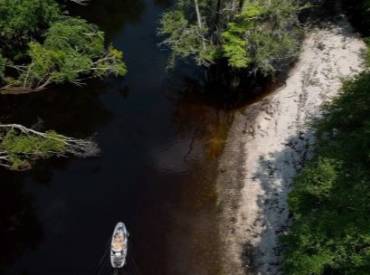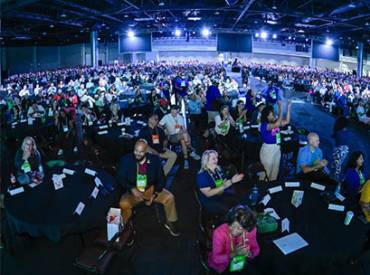
Honoring Native American Heritage Month — Episode 173
By Christina High and Cort Jones | Posted on November 25, 2025
On this episode of Open Space Radio, we reshare a conversation with Sara Sinclair and Stephanie Lozano filled with powerful history, examples of actions we can take, and the importance of leading with curiosity and humility.

“Environmentally-Friendly Park Management” Published by Sasaki and the National Recreation and Park Association (NRPA)
By Chris Hardy | Posted on November 20, 2025
“Environmentally-Friendly Park Management” is a guide that helps park and recreation agencies achieve their sustainability goals.

NRPA Tracking Impacts of Federal Shutdown
By Kyle Simpson | Posted on November 13, 2025
On November 12, Congress passed a stopgap spending package that officially ended the 44-day government shutdown — the longest in U.S. history.

Stronger Together: How NRPA and Bchex Elevate Park Safety
By Emma Baucom | Posted on November 4, 2025
Learn how NRPA members can get access to streamlined background screening tools tailored specifically to the recreation field.

An Open Space Radio Halloween: Spine-Chilling Tales from Parks and Recreation — Episode 172
By Cort Jones, Christina High, Cara Myers | Posted on October 28, 2025
Halloween is here, and Open Space Radio is celebrating with one of our most hauntingly fun episodes yet. In this special episode, we sit around the virtual campfire to share a few eerie tales from park and recreation professionals.

Celebrating the Heart of Youth Sports: Coach Appreciation Month
By Brian McFadden | Posted on October 22, 2025
Every October, Coach Appreciation Month gives us a chance to pause and honor the individuals who dedicate their time, energy and heart to shaping the next generation through sports.

Record Year for Seventh Annual Parks for Pollinators BioBlitz
By Rukmini Kalamangalam | Posted on October 21, 2025
In September, 120 organizations — from zoos and museums to local and state parks departments — came together to observe and document the incredible species that thrive in our parks through NRPA’s Parks for Pollinators BioBlitz.

Honoring Dr. Jane Goodall’s Legacy Through Parks
By Clement Lau | Posted on October 15, 2025
Dr. Jane Goodall's passing on October 1 at the age of 91 is a tremendous loss. Yet for all of us who care about parks, conservation and sustainability, her legacy continues to guide and motivate our work.

Level Up With Skill Builders — NRPA’s Newest Learning Opportunities
By Elyse Quinn | Posted on October 8, 2025
Designed directly from NRPA member feedback, Skill Builders offer quick, actionable learning that fits your schedule and budget.

Flowing Forward: LWCF’s Role in South Carolina’s Newest State Park
By Kaitlyn Brodie | Posted on October 6, 2025
This year has been especially transformative for the Black River as the South Carolina Department of Parks, Recreation and Tourism (SCPRT) received LWCF funding to acquire land around the river in May, and Black River State Park was established in January.

What Is a Training Grant and Why Should I Apply?
By Colleen Pittard | Posted on October 6, 2025
Training grants are grants that do not always provide funds, but instead provide training, coaching and technical assistance. Since 2016, NRPA has been offering instructor training grants for evidenced-based physical activity programs and we just opened applications for another round!

Stronger Together: Lessons in Partnership and Sustainability in Charles County, Maryland
By Steph Whyte | Posted on September 24, 2025
Like many park and recreation agencies, Charles County doesn’t have a horticulturist or sustainability expert on staff to inform where and what to plant or mow. Their success wasn’t about having ample capacity in-house; it was about partnering differently.

The Insider’s Guide to the 2025 NRPA Annual Conference — Episode 171
By Cort Jones, Cara Myers and Christina High | Posted on September 9, 2025
On this very special episode of Open Space Radio, we discuss all things 2025 NRPA Annual Conference and share some tips to help you feel informed and ready to make the most of your time in Orlando.

Beyond the Sidelines: Every Girl Deserves Her Chance to Play, Grow and Lead
By Brian McFadden and Michael Vaughan Cherubin | Posted on August 29, 2025
As part of this year’s pre-conference offerings at the 2025 NRPA Annual Conference in Orlando, Florida, NRPA is excited to join with the U.S. Soccer Foundation to bring you “Beyond the Sidelines: Elevating Girls' Participation in Park and Rec Sports.”

The Importance of Walking Paths
By Clement Lau, DPPD, FAICP | Posted on August 19, 2025
Walking paths are simple, low-cost features that deliver enormous benefits, from health and well-being to social connection and environmental awareness.

Back to School, Back to Belonging: How Park and Recreation Professionals Can Be Anchors for Youth This Fall
By Lisa Perry | Posted on August 14, 2025
Whether you’re overseeing afterschool programs, leading teen nights, coaching youth sports, or coordinating seasonal events, you’re likely one of the most consistent adult figures in a young person’s life outside of school and home.

Comebacks, Recovery and the Path to Exciting New Adventures: Asheville Parks & Recreation Shares Recovery Updates
By D. Tyrell McGirt | Posted on August 5, 2025
Asheville (North Carolina) Parks & Recreation Director D. Tyrell McGirt shares an update on recovery efforts following catastrophic destruction from Tropical Storm Helene 10 months ago.

Promises Kept: Parks and Progress in Uncertain Times
By Clement Lau, DPPD, FAICP | Posted on July 25, 2025
This Parks and Recreation Month, we celebrate more than just facilities and programs — we honor the perseverance and partnerships it takes to bring them to life. Because when we build together and play together, we do not just weather hard times — we rise above them.


